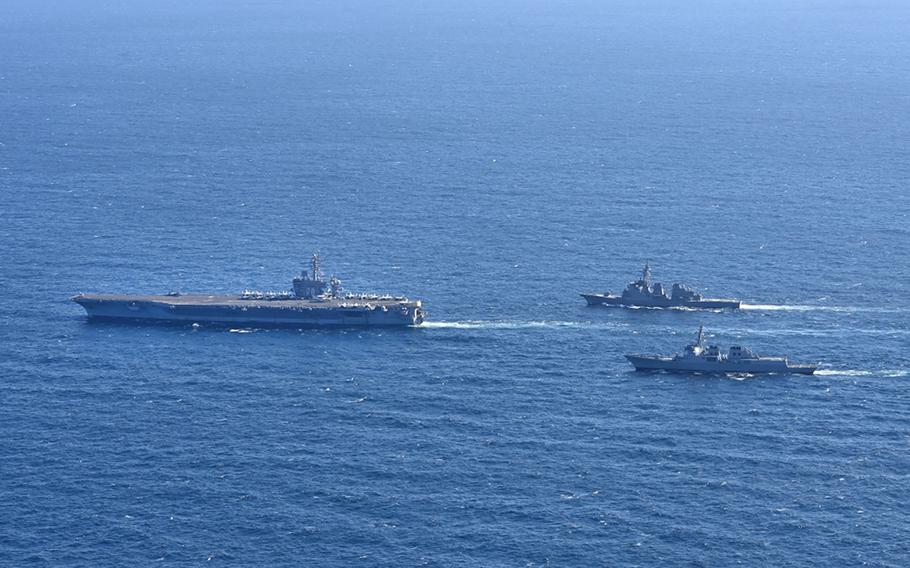
The aircraft carrier USS Carl Vinson trains with South Korean and Japanese destroyers this week near Jeju Island, South Korea. (South Korea’s Joint Chiefs of Staff)
OSAN AIR BASE, South Korea — Nine warships from the United States, South Korea and Japan kicked off a combined naval exercise south of the Korean Peninsula a day after North Korea fired its first ballistic missile of the year, Seoul announced Wednesday.
The aircraft carrier USS Carl Vinson and guided-missile cruiser USS Princeton joined South Korean and Japanese destroyers equipped with the Aegis missile-defense system in international waters near the South’s Jeju Island, according to a news release from the South Korean Ministry of National Defense.
The exercise — a three-day response to North Korea’s nuclear, missile and underwater threats — ended Wednesday, according to the ministry. The training will enhance the allies’ ability to respond to North Korean threats in a “joint capacity,” the release said.
The chairman of South Korea’s Joint Chiefs of Staff, Adm. Kim Myung-soo, visited the Carl Vinson during the exercise to inspect the training and personnel, according to the release.
The commander of U.S. Forces Korea, Army Gen. Paul LaCamera, met Kim aboard the carrier on Monday, USFK said in a separate news release Wednesday.
The carrier last appeared near Jeju Island in November for similar training with South Korean and Japanese destroyers.
The latest trilateral naval exercise started a day after North Korea fired an intermediate-range ballistic missile Sunday.
The solid-fueled missile — North Korea’s first launch this year — was launched near Pyongyang and traveled roughly 620 miles east before falling into the Sea of Japan, or East Sea, according to the South’s military.
North Korea’s state-run Korean Central News Agency in a report Monday described the missile as being tipped with a hypersonic warhead and that the test was a success.
Asked by email if the trilateral naval drill was scheduled prior to Sunday, U.S. Navy Region Korea spokeswoman Enjoli Janel Di Patri said the command “routinely trains with our allies.”
“Participating in training exercises enhances … and demonstrates our commitment to our partners, who share our resolve for peace and stability on the Korean Peninsula,” she wrote in an email Wednesday. “The work that we do with our allies and partners is crucial in boosting deterrence.”
Military cooperation between Washington, Seoul and Tokyo has increased under the leaders of the three countries. President Joe Biden, South Korean President Yoon Suk Yeol and Japanese Prime Minister Fumio Kishida met in August at Camp David, Md., and agreed to collectively respond to North Korea’s threats.
Two months after the pledge, air forces from the three countries conducted their first-ever aerial drill in which South Korean and Japanese fighter jets escorted a nuclear-capable U.S. B-52H Stratofortress bomber in air-defense zones overlapping South Korea and Japan.
The three allies also activated their real-time data-sharing system on North Korea’s missile launches in December.
The North criticized the U.S.-South Korea-Japan military drills in a KCNA report Tuesday and described it as “instigation” that threatens the country’s stability.
“The U.S. and its stooges are now buoyed with war fever,” the report said.